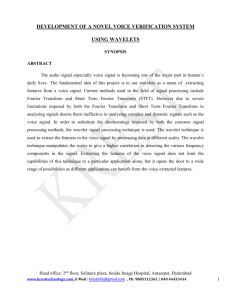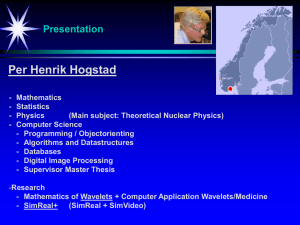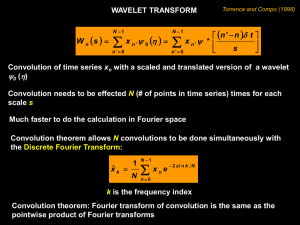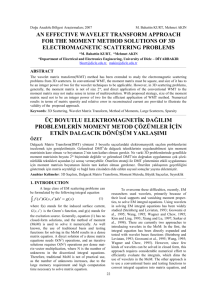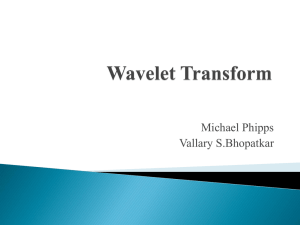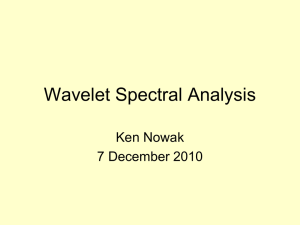slides
advertisement
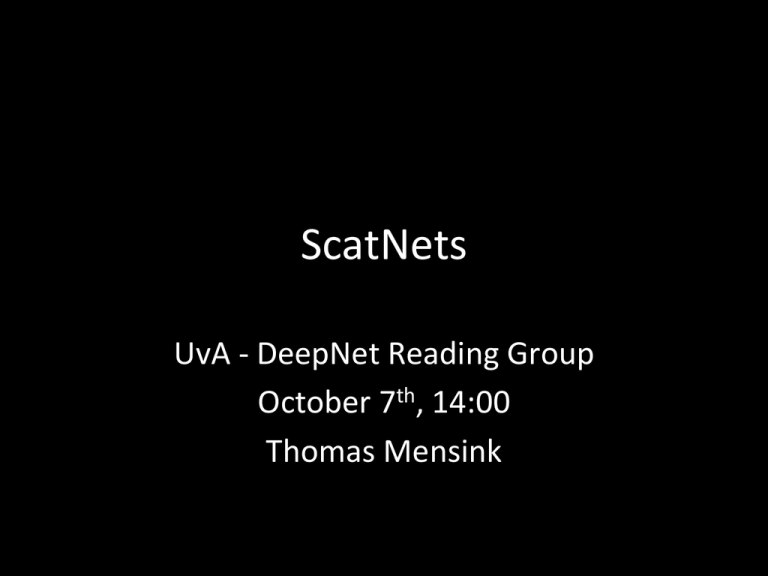
ScatNets UvA -­‐ DeepNet Reading Group October 7th, 14:00 Thomas Mensink The main problem of classifica2on is variance, there exist much to much variability in the data Stéphane Mallat Stéphane Mallat • And for a French Researcher his English is great Keynote at CVPR hOp://techtalks.tv/talks/plenary-­‐talk-­‐are-­‐deep-­‐networks-­‐a-­‐soluSon-­‐to-­‐curse-­‐of-­‐dimensionality/60315/ Part of this variability is due to rigid transla2ons, rota2ons, or scaling. This variability is o=en uninforma2ve for classifica2on J. Bruna & S. Mallat -­‐ PAMI 2013 • Pami SecSon 1 wavelet scaOering | translaSon invariant | deformaSons | high-­‐frequency informaSon | wavelet transform convoluSons | nonlinear modulus and averaging operators | staSonary processes | higher order moments | Fourier power spectrum | rigid translaSons, rotaSons, or scaling | Non-­‐rigid deformaSons | deformaSon invariant | linearize small deformaSons | Lipschitz conSnuous | Fourier transform modulus | Fourier transform instabiliSes | wavelet transforms are not invariant but covariant to translaSons | preserving the signal energy | expected scaOering representaSon (Just) SecSon 1 wavelet scaOering | translaSon invariant | deformaSons | high-­‐frequency informaSon | wavelet transform convoluSons | nonlinear modulus and averaging operators | staSonary processes | higher order moments | Fourier power spectrum | rigid translaSons, rotaSons, or scaling | Non-­‐rigid deformaSons | deformaSon invariant | linearize small deformaSons | Lipschitz conSnuous | Fourier transform modulus | Fourier transform instabiliSes | wavelet transforms are not invariant but covariant to translaSons | preserving the signal energy | expected scaOering representaSon Help! I lack engineering/math skills High-­‐level idea • ConvNet • ScatNet: replace learned layers by predefined scaOering operators ScatNets ScatNets (2) • MathemaScal approach • Signal processing view • On ConvNets / DeepNets • Use known invariance properSes • To construct a deep hierarchical network TranslaSon Invariant Linearize DeformaSons • Small deformaSon x -­‐> x’ -­‐> distance bounded TranslaSon Invariant RepresentaSons • Not stable for deformaSons: – AutocorrelaSons – Fourier Transform Modulus • Stable for deformaSons: – Wavelet Transform Wavelets • Used in the JPG2000 compression scheme ture stated in [Mal12], relating the signal sparsity with the regularity
ews
the scattering
for deterministic
functions and processes,
presentation
in thetransform
transformed
domain.
mathematical
properties.
It invariant,
also studies
these
properties
on signal
image
esentations [Mal12]
construct
stable
and
informative
and obtains
new mathematical
results:
the first
characytions,
cascading
wavelettwo
modulus
decompositions
followed
by one
a lowpass
earities from stability
the second
one giving a partial
ecomposition
operator constraints,
at scale J isand
defined
as
ture stated in [Mal12], relating the signal sparsity with the regularity
presentation inWthe
transformed
{x ⋆ ψλ }λ∈Λdomain.
,
Jx =
J
resentations [Mal12] construct invariant, stable and informative signal
−j r −1 u) and λ = 2j r, with j < J and r ∈ G belongs to a finite
ydj ψ(2
cascading
wavelet modulus decompositions followed by a lowpass
of Rd . Each operator
rotated and
dilated
ecomposition
at scale
J iswavelet
defined thus
as extracts the energy
given scale and orientation given by λ. Wavelet coefficients are not
WJ x =does
{x ⋆not
ψλ }produce
nt, and their average
λ∈ΛJ , any information since wavelets
A translation invariant measure can be extracted out of each wavelet
dj ψ(2−j r −1 u) and λ = 2j r, with j < J and r ∈ G belongs to a finite
oducing a non-linearity which restores a non-zero, informative average
of Rd . Each
rotated
and dilated
extracts
energy
instance
achieved
by computing
thewavelet
complexthus
modulus
and the
averaging
given scale and orientation
given by λ. Wavelet coefficients are not
!
nt, and their average
not produce
any information since wavelets
|xdoes
⋆ ψλ |(u)du
.
A translation invariant measure can be extracted out of each wavelet
oducing
a non-linearity
restores
informative
average
ost
by this
averaging iswhich
recovered
by aanon-zero,
new wavelet
decomposition
instance achieved by computing the complex modulus and averaging
ΛJ of |x ⋆ ψλ |, which produces new invariants by iterating the same
! the wavelet modulus operator corresponding to
λ]x = |x ⋆ ψλ | denote
ny sequence p = (λ1 ,|x
λ2⋆, ...,
a path, i.e, the ordered product
ψλλ|(u)du
.
m ) defines
Wavelets Operators • Two important parts • Wavelet operator: • And translaSon invariant measure 1
&j2
!1
j2
or !2 ¼ 2 r2 , the scale 2 divides the radial axis,
resulting sectors are subdivided into K angular
orresponding to the different r2 . The scale and
ubdivisions are adjusted so that the area of each
s proportional to kj !1 j ? !2 k2 .
much fewer internal and output coefficients.
The norm and distance on a transform T x ¼ fx
output a family of signals will be defined by
X
0 2
kxn & x0n k2 :
kT x & T x k ¼
ScaOering Coefficients n
Two images xðuÞ. (b) Fourier modulus j^
xð!Þj. (c) First-order scattering coefficients Sx½!1 " displayed over the frequenc
ey are the same for both images. (d) Second-order scattering coefficients Sx½!1 ; !2 " over the frequency sectors of Fig. 3
r each image.
ScatNet ND MALLAT: INVARIANT SCATTERING CONVOLUTION NETWORKS
e applied to x computes the first layer of wavelet coefficients modulus U½"1 (x ¼ jx ? "1 j and outputs it
scattering propagator W
e to the first layer signals U½"1 (x outputs first-order scattering coefficients S½"1 ( ¼ U½"1 ( ? !2J
S½;(x ¼ x ? !2J (black arrow). Applying W
e to each propagated signal U½p(x outputs S½p(x ¼ U½p
and computes the propagated signal U½"1 ; "2 (x of the second layer. Applying W
rows) and computes the next layer of propagated signals.
ScatNet Screenshot from cvpr keynote ScatNets A scaOering transform builds nonlinear invariants from wavelet coefficients, with modulus and averaging pooling funcSons. • localized waveforms -­‐> stable to deformaSons • Several layers construct large scale invariants without losing crucial informaSon KS
7Þ
1877
•
ScatNet TABLE
P 1
Percentage of Energy p2P m kS½p(xk2 =kxk2 of
#
Scattering Coefficients on Frequency-Decreasing Paths
Signal processing view: preserve upon
energy of Length
m, Depending
J
l,
8Þ
e
a-
These average values are computed on the Caltech-101 database, with
zero
mean
unit variance
images. depth can be limited • This is and
important: network with a negligible loss of signal energy This scattering energy conservation also proves that the
more sparse the wavelet coefficients, the more energy
Results (1) Screenshot from cvpr keynote Results (2) IEEE TRANSACTIONS ON PATTERN ANALYSIS AND MACHINE INTELLIGENCE,
VOL. 35,
N
MNIST classificaSon TABLE 4
Percentage of Errors of MNIST Classifiers, Depending on the Training Size
scattering models can be interpreted as
els computed independently for each class.
discriminative classifiers such as SVM, we
te cross-correlation interactions between
optimizing the model dimension d. Such
and fourth columns give the classificatio
with a PCA or an SVM classification applie
of a windowed Fourier transform. The spa
window is optimized with a cross valida
minimum error for 2J ¼ 8. It correspond
MNIST Example UNA AND MALLAT: INVARIANT SCATTERING CONVOLUTION NETWORKS
g. 7. (a) Image XðuÞ of a digit “3.” (b) Arrays of windowed scattering coefficients S½p'XðuÞ of order m ¼ 1, with u sampled at intervals
xels. (c) Windowed scattering coefficients S½p'XðuÞ of order m ¼ 2.
iginal dataset, thus improving upon previous state-of-thet methods.
To evaluate the precision of affine space models, we
mpute an average normalized approximation error of
The US-Postal Service is another handwritt
dataset, with 7,291 training samples and 2,007 tes
of 16 % 16 pixels. The state of the art is obtain
tangent distance kernels [14]. Table 6 gives results
Preliminary conclusion • Elegant idea and intuiSon – First layers of deep network can be defined using known image / physical properSes • (Quite) difficult maths – Requires knowledge from wavelet transforms, Fourier series, complex numbers etc – Seems not all symbols etc are well explained (for the amateur reader at least). Next session • Keynote CVPR – hOp://techtalks.tv/talks/plenary-­‐talk-­‐are-­‐deep-­‐
networks-­‐a-­‐soluSon-­‐to-­‐curse-­‐of-­‐dimensionality/
60315/ • Taco Cohen: ScaOering and Invariants
